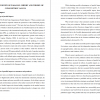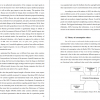PARALLEL IMPORTED GOODS AND CONSUMPTION VALUES IN RUSSIA
|
INTRODUCTION 7
CHAPTER 1. OVERVIEW OF PARALLEL IMPORT AND THEORY OF
CONSUMPTION VALUES 9
1.1 Parallel import 9
1.2 Theory of consumption values 16
CHAPTER 2. METHODOLOGY 19
2.1 Research design 19
2.2 Research model constructs 20
2.3 Data collection 26
CHAPTER 3. DATA ANALYSIS AND RECOMMENDATIONS 28
3.1 Exploratory factor analysis 28
3.2 Confirmatory factor analysis 29
3.3 Simultaneous CFA 35
3.4 Full Structural equation modeling 37
3.5 Initial hypotheses testing 38
3.6 Discussion and implications 39
3.7 Limitations and further research 40
CONCLUSION 42
References 43
Appendix 46
CHAPTER 1. OVERVIEW OF PARALLEL IMPORT AND THEORY OF
CONSUMPTION VALUES 9
1.1 Parallel import 9
1.2 Theory of consumption values 16
CHAPTER 2. METHODOLOGY 19
2.1 Research design 19
2.2 Research model constructs 20
2.3 Data collection 26
CHAPTER 3. DATA ANALYSIS AND RECOMMENDATIONS 28
3.1 Exploratory factor analysis 28
3.2 Confirmatory factor analysis 29
3.3 Simultaneous CFA 35
3.4 Full Structural equation modeling 37
3.5 Initial hypotheses testing 38
3.6 Discussion and implications 39
3.7 Limitations and further research 40
CONCLUSION 42
References 43
Appendix 46
After the February of 2022 many foreign companies closed their Russian subsidiaries. Those who have been exporting to Russia announced the cessation of supplies. All this resulted in the fact that soon, after all the warehouses got empty, many Russian citizens would face the lack of goods from Europe and the US. The changes would be noticeable in different fields: starting from clothing (H&M, Zara) to car industry (Ford, BMW).
Even though some people might think that this would be good for the Russian economy as there would be less competition in the market and people would buy things produced by Russian firms, still the government decided to use legislation to permit the import of the banned goods through third countries. In order to do so the new resolution was adopted in March of 2022. According to this resolution, some categories of goods could be exported through thirds countries without any prosecution. Later, in May of 2022, The Ministry of Industry and Trade of the Russian Federation (Minpromtorg) approved the list of goods and trademarks, parallel import of which was permitted. The list consisted of hundreds of trademarks in different industries: car industry (Tesla, Land Rover, Jeep), car parts (Hyundai, Nissan, Volkswagen), tires (Continental, Michelin), electronics (Dyson, Apple, Samsung), gaming consoles (PlayStation, Xbox). In total more than 50 product groups, including textiles, leather goods, clothing, furs, perfumes.
While it may seem that the resolution made it possible to buy brand-new foreign goods as it used to be, there are still many risks and obstacles that both customers and importers are facing. When it comes to customers one of the drawbacks is the price increase. If in the past a good needed to be transported from a country producer to a country importer - now there is also a third party that buys the good from the producer and then, through third country transports it to Russia. All these extra steps will result in the price increase that a regular customer will have to cover. Secondly, amid big scales of parallel import a bigger number of counterfeit goods are imported. Only in 2022 there was a 17% increase in number of counterfeit goods, from 7 mln. in 2021 to 8.2 mln. in 2022 (Shavshina, 2023). When in comes to those who are trying to use this opportunity to earn by reselling goods, there are also possible obstacles. One of them is the fact that the list of goods permitted to be parallelly imported is never fixed. With new versions, some goods are being put into the list, some are being taken out. In such instability it is hard to plan regular supplies if some categories could be excluded by law in the matter of days.
Considering the fact that it has been just over two years since significant changes were introduced, there is still little research in the field of parallel imported goods and the way Russian customers treat them. It is possible that some groups of people have become more in favor of domestic goods, after feeling betrayed when global companies left Russia. It is also possible that for some groups of people the ability to buy familiar foreign goods is important even when it may lead to price increase and uncertainty of supply...
Even though some people might think that this would be good for the Russian economy as there would be less competition in the market and people would buy things produced by Russian firms, still the government decided to use legislation to permit the import of the banned goods through third countries. In order to do so the new resolution was adopted in March of 2022. According to this resolution, some categories of goods could be exported through thirds countries without any prosecution. Later, in May of 2022, The Ministry of Industry and Trade of the Russian Federation (Minpromtorg) approved the list of goods and trademarks, parallel import of which was permitted. The list consisted of hundreds of trademarks in different industries: car industry (Tesla, Land Rover, Jeep), car parts (Hyundai, Nissan, Volkswagen), tires (Continental, Michelin), electronics (Dyson, Apple, Samsung), gaming consoles (PlayStation, Xbox). In total more than 50 product groups, including textiles, leather goods, clothing, furs, perfumes.
While it may seem that the resolution made it possible to buy brand-new foreign goods as it used to be, there are still many risks and obstacles that both customers and importers are facing. When it comes to customers one of the drawbacks is the price increase. If in the past a good needed to be transported from a country producer to a country importer - now there is also a third party that buys the good from the producer and then, through third country transports it to Russia. All these extra steps will result in the price increase that a regular customer will have to cover. Secondly, amid big scales of parallel import a bigger number of counterfeit goods are imported. Only in 2022 there was a 17% increase in number of counterfeit goods, from 7 mln. in 2021 to 8.2 mln. in 2022 (Shavshina, 2023). When in comes to those who are trying to use this opportunity to earn by reselling goods, there are also possible obstacles. One of them is the fact that the list of goods permitted to be parallelly imported is never fixed. With new versions, some goods are being put into the list, some are being taken out. In such instability it is hard to plan regular supplies if some categories could be excluded by law in the matter of days.
Considering the fact that it has been just over two years since significant changes were introduced, there is still little research in the field of parallel imported goods and the way Russian customers treat them. It is possible that some groups of people have become more in favor of domestic goods, after feeling betrayed when global companies left Russia. It is also possible that for some groups of people the ability to buy familiar foreign goods is important even when it may lead to price increase and uncertainty of supply...
This master thesis was devoted to explore the consumption value factors influencing the intention of Russian consumers to buy parallel imported goods and, based on these findings, to formulate practical recommendations for Russian companies. Through a comprehensive analysis, this research provides valuable insights into consumer behavior towards parallel imports, contributing both theoretically and practically to the field.
In the first chapter, an overview of parallel import was provided, discussing its significance and implications in the global market, with a specific focus on Russia. The theoretical foundation of this work was the theory of consumption values. This theory has not only been tested in multiple contexts of consumer behavior, but it also provides comprehensive approach to investigating the root causes of Russian customers and their intention to buy parallel imported goods.
The second chapter detailed the methodology used in this study. Building on the TCV, the model was proposed to test the consumption values in relation to parallel import in Russia. This chapter described the process of data collection through a questionnaire via google form in Telegram and Vkontakte. The collected data sample was checked using descriptive statistics and Cronbach’s alpha coefficient to ensure that the data is valid and reliable. The methodological tests applied in this chapter ensured that the future analysis was based on a high-quality data, which is essential for future findings.
In the third chapter, an extensive data analysis was conducted using various statistical techniques. This included Exploratory Factor Analysis (EFA), Confirmatory Factor Analysis (CFA), simultaneous CFA, and Structural Equation Modeling (SEM). Through these analyses, it was discovered that functional and conditional values have a significant positive effect on the intention to purchase parallel imported goods. This finding highlights the importance of practical benefits and situational factors in shaping consumer intentions. Additionally, the theoretical and practical contributions of the work were discussed. Theoretically, this research highlights the readiness of Russian consumers to choose non-traditional retail channels in the future, while practically, it provides actionable insights for Russian producers to understand and leverage obtained information in order to make local goods more appealing to Russian customers.
In the first chapter, an overview of parallel import was provided, discussing its significance and implications in the global market, with a specific focus on Russia. The theoretical foundation of this work was the theory of consumption values. This theory has not only been tested in multiple contexts of consumer behavior, but it also provides comprehensive approach to investigating the root causes of Russian customers and their intention to buy parallel imported goods.
The second chapter detailed the methodology used in this study. Building on the TCV, the model was proposed to test the consumption values in relation to parallel import in Russia. This chapter described the process of data collection through a questionnaire via google form in Telegram and Vkontakte. The collected data sample was checked using descriptive statistics and Cronbach’s alpha coefficient to ensure that the data is valid and reliable. The methodological tests applied in this chapter ensured that the future analysis was based on a high-quality data, which is essential for future findings.
In the third chapter, an extensive data analysis was conducted using various statistical techniques. This included Exploratory Factor Analysis (EFA), Confirmatory Factor Analysis (CFA), simultaneous CFA, and Structural Equation Modeling (SEM). Through these analyses, it was discovered that functional and conditional values have a significant positive effect on the intention to purchase parallel imported goods. This finding highlights the importance of practical benefits and situational factors in shaping consumer intentions. Additionally, the theoretical and practical contributions of the work were discussed. Theoretically, this research highlights the readiness of Russian consumers to choose non-traditional retail channels in the future, while practically, it provides actionable insights for Russian producers to understand and leverage obtained information in order to make local goods more appealing to Russian customers.





